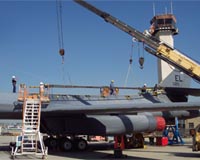| . |  |
. |
Hancom AFB MA (SPX) Jun 02, 2009 Equipping warfighters with the technology to detect moving targets in combat gained momentum when Electronic Systems Center officials here, in concert with prime contractors and other organizations, recently completed a key flight milestone for the Multiplatform Radar Technology Insertion Program. "At this point, we're delivering on the promise of advanced radar capability for the Global Hawk with completion of GMTI and SAR modes," said Col. Jim Shaw, commander of the 851st Electronic Systems Group, which is leading the effort. "This is a capability that the warfighter needs in the overseas theater today," he said. Radar system level performance verification testing on the advanced electronically-scanned array radar system verified performance of the Synthetic Aperture Radar, or SAR, and Ground Moving Target Indicator, or GMTI, modes. SAR imagery includes collection of high-resolution spot images, while GMTI focuses on moving ground targets. The testing was conducted on a Proteus test aircraft. "The sensor performed very well on SAR, and clearly exceeded warfighter requirements in the GMTI modes," the colonel said. The testing included 186 flights with 1,063 flight hours on Proteus. Of those, 64 flights and 376 flight hours were needed to complete the testing, referred to as RSLPV, after a focus on calibration issues in late August and early September 2008. Program managers hope to incorporate the sensor onto the first production Block 40 Global Hawk. The Global Hawk is a high-altitude, long-endurance unmanned aircraft system with an integrated sensor suite that provides intelligence, surveillance and reconnaissance capability worldwide. Its mission is to provide a broad spectrum of ISR collection capability to support joint combatant forces in worldwide peacetime, contingency and wartime operations. The Global Hawk complements manned and space reconnaissance systems by providing near-real-time coverage using imagery intelligence sensors. The sensor brings with it the capability to detect targets + either in air, land or sea + and then establish a communications link. This allows Air Force officials to conduct ground surveillance and track things like suspicious vehicles, troop movement and other potential threats. "The war we're fighting in Iraq, and particularly Afghanistan, requires us to find the moving targets and activity in the combat theater," Colonel Shaw said. The testing included examining software, controlling and operating the radars and ensuring the different modes were optimized to run on the developed hardware. Flights were also completed with no mishaps and little down-time, according to the colonel. Colonel Shaw attributed reaching this milestone to the hard work and dedication of a combined industry and government team. "I'm impressed with the technical capabilities that the contractor has to offer, as well as the strength of our ESC team," the colonel said. "There were a lot of late nights and long hours involved in delivering this capability." Mode development is slated to continue, along with additional focus on issues detected during government testing. The sensor will also undergo structural modification and re-calibration, with plans to turn it over to Global Hawk Air Force 18 + the service's Block 40 test bed. Share This Article With Planet Earth
Related Links - The latest in Military Technology for the 21st century at SpaceWar.com
 Boeing Team Rebuilds B-1 Backbone For USAF
Boeing Team Rebuilds B-1 Backbone For USAFLong Beach CA (SPX) Jun 02, 2009 A U.S. Air Force B-1B bomber returned to flight last week after a team led by Boeing replaced its catastrophically damaged upper-center boron longeron - the aircraft's "backbone." The B-1, Swift Justice, was damaged during a routine training mission in December 2007. An engine-bleed air duct rupture triggered a temperature warning light, forcing the crew to land the aircraft at Ellsworth ... read more |
|
| The content herein, unless otherwise known to be public domain, are Copyright 1995-2009 - SpaceDaily. AFP and UPI Wire Stories are copyright Agence France-Presse and United Press International. ESA Portal Reports are copyright European Space Agency. All NASA sourced material is public domain. Additional copyrights may apply in whole or part to other bona fide parties. Advertising does not imply endorsement,agreement or approval of any opinions, statements or information provided by SpaceDaily on any Web page published or hosted by SpaceDaily. Privacy Statement |